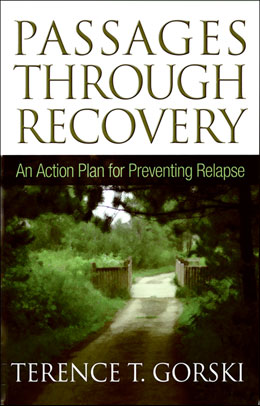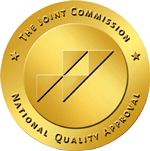
"If we spend most of our time trying to solve problems that are impossible to solve, we will not have the energy to solve problems that we are capable of solving."

Other titles you may like.

A Man's Way Through the Twelve Steps

A Program for You: A Guide to the Big Book's Design for Living
Visit Recovery Road to view and
listen to all the episodes.
Episode 219 -- May 19, 2022
Problem Solving in Seven Steps
Before recovery, most of us took a drink or a drug and thought things over—it was our all-purpose problem solver. Now, we must learn new ways of solving problems, and build new skills to help us cope when we're confused or having trouble. This can be challenging when we're just figuring out what works for us and what doesn't in sobriety. Recovery is a learning process—and so is managing stress—but we can learn patience as well as the skills that will help us to tackle our problems effectively.
In his book Passages Through Recovery: An Action Plan for Preventing Relapse, Terence Gorski describes the challenges of moving from active addiction to sobriety. He outlines the way this process happens through six stages. Gorski's insights are based on the wisdom and experiences of thousands of men and women who walked this path before us. We can use this book as a compass to stay on the course of recovery.
The following excerpt involves the stabilization stage of the recovery process. Stabilization is when we're learning to live a life without drugs or alcohol and becoming aware of the realities of our lives. In addition to maintaining chemical sobriety during this stage, we need to learn how to approach problems without resorting to our old methods. Here, Gorski offers a seven-step strategy that uses questions to help us manage stress and solve problems.
This excerpt has been edited for brevity.
Learning Nonaddictive Ways of Managing Stress
We now have to face the painful realities of our lives. During stabilization, most of us have serious problems with our spouse, family, friends, or job. Our awareness of these problems creates stress, and we must learn to manage it.
To pass through this stage of our recovery successfully, we must learn nonaddictive problem-solving strategies. We often learn these strategies from being around others and watching what they do. When we are with someone long enough, we begin to do what they are doing without thinking about it. An AA member once put it this way: "If you bring your body to enough meetings and spend time with enough sober drunks, the program wears off on you."
Most of us don't know how to solve problems during this time. For years, our approach has been to take a drink or a drug and think things over. Alcohol and other drugs was our all-purpose problem solver. It is important to learn new ways of solving problems. The most helpful problem-solving strategy I have found asks us to solve a problem in seven stages.
1. Problem identification. At the first sign of a problem, stop and say to yourself, I have a problem, and I need to do something about it. Then take a deep breath and ask yourself, What's really going on right now? Formulate a response in your mind. You'll probably come up with a general statement like, My job's lousy or I can't handle my spouse. This is a good start. If you know something is wrong but can't put the problem in words, it is helpful to ask yourself questions about the key areas of your life, such as: What is bothering me about myself right now? What is bothering me about my spouse or family right now? What is bothering me about my job right now? What is bothering me about my recovery program right now?
2. Problem clarification. The next step is to figure out exactly what the problem is. It won't be helpful to be general or vague at this stage; you have to be concrete and specific. Ask yourself, Exactly what is going on right now that I'm having difficulty handling? Who is involved? Write down specifics. Where am I when this problem occurs? Pretend you're a newspaper reporter and ask the questio WHO, WHAT, WHEN, WHERE, WHY, and HOW. Some typical questions are What exactly am I or other people doing that makes this situation a problem? When does this happen? Where am I when it happens? Why am I experiencing this as a problem? How am I interpreting the situation that makes it more stressful than it really is?
It is also helpful to ask a series of questions about different areas of your life that are affected by this problem, such as How am I affected? How is my spouse and family affected? How is my job affected?
Trying to answer the questions in your head can lead to confusion. Many people find it helpful to write out their answers; this way, it is much easier to see exactly what is going on. One person I worked with said: "I hate writing this stuff down, but it does force me to sort out my head. When I think about it, I get confused and shift endlessly from one thing to another. When I write it down, I force myself to figure out exactly what is wrong."
While you are clarifying your problems, it's important to talk with other people. If we knew what the problem was, we'd be able to deal with it. Ninety percent of the problem-solving process is knowing exactly what is wrong. We can't do that by ourselves because we lack objectivity. We need help.
3. Identification of alternatives. The next step is to determine different ways the problem can be addressed. If you believe there is only one possible way to solve a problem, you may be locked into an irrational way of thinking. Most problems have more than one solution, but our addictive thinking keeps us from seeing other options. If you believe there is one and only one way to solve a problem, you probably need the help of someone else to give you a better perspective. I generally recommend that people not take action to solve the problem until they can see at least three different ways to approach it.
There are some problems that we just cannot solve. There's very little I can do about the weather, our country's relationship with other countries, or a forest fire in a distant state. My solution to these problems is to adjust my attitude toward them and accept that there is nothing I can do. In AA terminology, I need to turn those problems over to my Higher Power. If we spend most of our time trying to solve problems that are impossible to solve, we will not have the energy to solve problems that we are capable of solving
4. Examination of alternatives. A sign on the wall of many recovery houses advises us to "THINK, THINK, THINK." What is it we're being asked to think about? We need to think about the consequences of our behavior. We live in a world that is governed by the law of consequences. For every action, there is a reaction. It is possible to accurately predict the consequences of our actions most of the time. But developing this kind of good judgment requires practice. The exercise I recommend is to take each action and answer three questions: If I take this action, what is
- the best thing that could happen?
- the worst thing that could happen?
- the most likely thing that will happen?
Remember this formula; it's important. What is the best, the worst, and the most likely thing that will happen if you attempt a specific response to a problem?
5. Decision. Decide what you are going to do. It is important to make a decision to do something differently, to move ahead with your recovery.
6. Action. Once you decide what to do, you have to do it. I used to have a poster hanging in my office that reads as follows:
There are many bleached bones on the
battlefield of decision,
Because at the moment of decision
people pause
And die in the waiting.
Many people in AA say: Easy Does It But Do It. Pray for Potatoes But Be Willing to Pick Up a Hoe. Turn It Over But Do the Legwork.
7. Evaluation. After you act, it is important to evaluate what happened. There is always an outcome. What we do works or it doesn't. Things get better, stay the same, or get worse. The important thing is to try and learn from the consequences. We are all fallible human beings. No matter how carefully we try to solve problems, we sometimes fail. Thomas Edison failed countless times before he found the right way to make a light bulb.
The evaluation period is essential, but remember that if your action doesn't correct the problem, you are not a failure. You have learned something—that what you tried didn't work. If something doesn't work, try something else the next time. Many people simply recycle solutions that don't work.
The evaluation process answers the question, "Did it work or do I need to seek out another solution to the problem?"
About the Author:
TERENCE T. GORSKI, M.A., C.A.C., was a nationally recognized lecturer, an acknowledged leader in the chemical dependency and codependency fields, and a workshop facilitator specializing in relapse prevention, intimacy in recovery, and treating chemically dependent adult children of alcoholics. Over decades of clinical experience and research, Gorski developed a comprehensive approach to recovery that revolutionized the field of relapse prevention. He is the author of Getting Love Right, Managing Cocaine Craving, and Staying Sober (with Merlene Miller), all available from Hazelden.
© 1989 by Terence T. Gorski
All rights reserved


